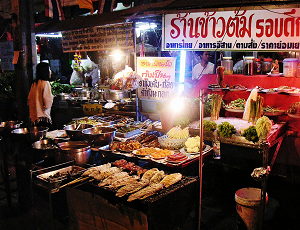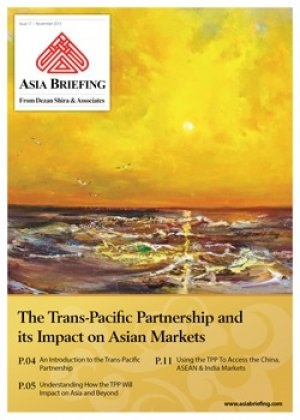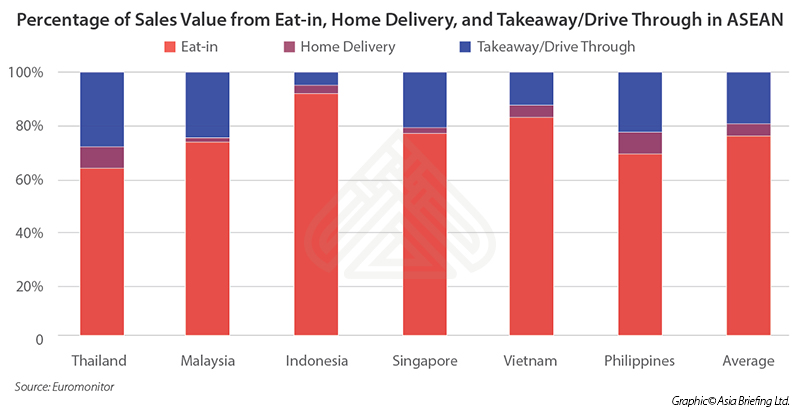Hungry for More: A Taste of ASEAN’s Foodservice Industry
By Harry Handley
 Southeast Asia is one of the four key target regions for international expansion in the consumer foodservice industry for 2017, according to Euromonitor research. ASEAN boasts a well-developed food culture, as well as a consumer preference for dining-out and a young, curious, and experimental population.
Southeast Asia is one of the four key target regions for international expansion in the consumer foodservice industry for 2017, according to Euromonitor research. ASEAN boasts a well-developed food culture, as well as a consumer preference for dining-out and a young, curious, and experimental population.
To support the development of the region’s foodservice industry, the ASEAN secretariat introduced a new food safety policy in 2016. The policy sets out 10 principles aimed at harmonizing food safety regulations and advancing regional integration in the industry. ASEAN leaders hope that a more closely integrated and transparently regulated market will lead to further interest from international companies.
As ASEAN’s foodservice industry gradually becomes more integrated, opportunities for regional expansion are rife. However, catering to local tastes in the foodservice industry is crucial, and though they share commonalities, each Southeast Asian country also boasts their own unique consumer preferences. Consequently, both identifying the preferences of the target market and choosing the appropriate entry model is instrumental to achieving success in the region.
![]() RELATED: Pre-Investment and Market Entry Advisory from Dezan Shira & Associates
RELATED: Pre-Investment and Market Entry Advisory from Dezan Shira & Associates
The state of ASEAN’s foodservice market
Regional restaurant sales totaled more than US$100 billion in 2015, a market size equivalent to that of India or Brazil. The compound annual growth rate (CAGR) of sales value in the six leading ASEAN economies from 2010 to 2015 was 2.65 percent; with Vietnam having the highest (6.5 percent), and Singapore the lowest (0.3 percent). The early stage of development of the Vietnamese market and high rent prices in Singapore, which stifle growth in the industry, explain this difference. In spite of this modest growth, as the increased integration of the ASEAN economic community begins to have an effect, the market as a whole is expected to grow more rapidly.
In general, the ASEAN foodservice industry is led by established international brands, mainly through joint ventures or franchising agreements with local companies. This dominance is due to the economies of scale and aggressive marketing campaigns of these global players. Vietnam is the exception; international brands have struggled to gain market share and independent local sellers control the market with their low-priced offerings. However, independent operators are also gaining traction in the other ASEAN markets; young entrepreneurs are challenging the market and creating offerings that capture the imaginations of local consumers.
Consumer trends
Despite the diversity of these six ASEAN countries, there are a number of common trends developing across the whole region. Firstly, dining out is becoming a lifestyle choice for many consumers in Southeast Asia, so it is becoming as much about the experience of dining out as it is about the food itself. Food courts and modern food halls are thriving across ASEAN. The selection of food on offer, as well as the bustling atmosphere – reminiscent of the region’s traditional hawker centers – are cited by Euromonitor as the reasons for this preference.
Due to the experiential element of dining out, it is still eat-in sales that make up the majority of the revenue of ASEAN’s foodservice providers (see graph below). In Indonesia, 91.6 percent of foodservice revenue comes from eat-in sales, the highest in the region; Thailand has the lowest at 63.5 percent. Although less than one percent of food orders were made online in 2015, revenue for online food orders in the region is expected to exceed US$1 billion in 2016 and to grow by almost 35 percent annually over the next five years. The increasingly digital nature of consumers’ lifestyles is prompting foodservice companies in Southeast Asia to alter their marketing and service delivery strategies. As such, many restaurants have partnered with local online ordering and delivery service providers in an attempt to expand their sales channels.
Another important factor to take into consideration in Southeast Asia is tourists. In 2015, over 100 million tourists visited ASEAN countries and 10 percent of tourist receipts were food and beverage purchases. Tourists typically wish to experience the local cuisine when travelling, but are also often willing to pay a premium for home comforts. This presents opportunities for both local vendors and international brands in the heavily touristic areas that ASEAN has to offer.
![]() RELATED: IP Protection in Malaysia’s Food & Beverage Industry
RELATED: IP Protection in Malaysia’s Food & Beverage Industry
Strategic considerations
By far the most common entry mode for foodservice in ASEAN is franchising. This is advantageous for the local franchisee who can exploit the existing marketing and brand recognition of the franchisor. Conversely, the relatively small capital requirements (compared to joint venture or wholly owned subsidiary entry) make this an attractive choice for foreign foodservice companies. However, the shift in control from the franchisor to the franchisee means that franchise agreements must be properly monitored in order to maintain a strong brand image.
Another popular method of entry for foreign foodservice companies are joint ventures with local partners, before offering franchise opportunities to local entrepreneurs. Particularly in an industry where local preference is so important, local partners give indispensable insights into their respective markets. Partner selection can make or break a joint venture; therefore, rigorous due diligence must be conducted prior to establishing a one. As well as financial due diligence, the size, ambitions, and cultural fit of the potential partner should be evaluated.
Increasingly, international brands are using joint ventures to implement a ‘glocalisation’ strategy – adapting a global offering to meet local needs. Such a strategy can be seen in many fast-food chains that offer country-specific products, for example, the substitution of bacon for a beef alternative by Burger King in Malaysia due to the Muslim population and their beliefs. It is these fine tweaks that can propel an international brand from outsider to challenger, and it is often a local partner that provides the insights to make these changes.
As a whole, the ASEAN market presents significant opportunities for international foodservice companies. The local preference for dining out as well as the constant flow of tourists offer a large target market. The high propensity for franchises and joint ventures also means there are countless local partners ready to bring international brands to their market. Having said that, as with any expansion project, it is vital to choose the correct location and partner for one’s company.
|
Asia Briefing Ltd. is a subsidiary of Dezan Shira & Associates. Dezan Shira is a specialist foreign direct investment practice, providing corporate establishment, business advisory, tax advisory and compliance, accounting, payroll, due diligence and financial review services to multinationals investing in China, Hong Kong, India, Vietnam, Singapore and the rest of ASEAN. For further information, please email asean@dezshira.com or visit www.dezshira.com. Stay up to date with the latest business and investment trends in Asia by subscribing to our complimentary update service featuring news, commentary and regulatory insight. |
Annual Audit and Compliance in ASEAN
For the first issue of our ASEAN Briefing Magazine, we look at the different audit and compliance regulations of five of the main economies in ASEAN. We firstly focus on the accounting standards, filing processes, and requirements for Indonesia, Malaysia, Thailand and the Philippines. We then provide similar information on Singapore, and offer a closer examination of the city-state’s generous audit exemptions for small-and-medium sized enterprises.
 The Trans-Pacific Partnership and its Impact on Asian Markets
The Trans-Pacific Partnership and its Impact on Asian Markets
The United States backed Trans-Pacific Partnership Agreement (TPP) includes six Asian economies – Australia, Brunei, Japan, Malaysia, Singapore and Vietnam, while Indonesia has expressed a keen willingness to join. However, the agreement’s potential impact will affect many others, not least of all China. In this issue of Asia Briefing magazine, we examine where the TPP agreement stands right now, look at the potential impact of the participating nations, as well as examine how it will affect Asian economies that have not been included.
 An Introduction to Tax Treaties Throughout Asia
An Introduction to Tax Treaties Throughout Asia
In this issue of Asia Briefing Magazine, we take a look at the various types of trade and tax treaties that exist between Asian nations. These include bilateral investment treaties, double tax treaties and free trade agreements – all of which directly affect businesses operating in Asia.









